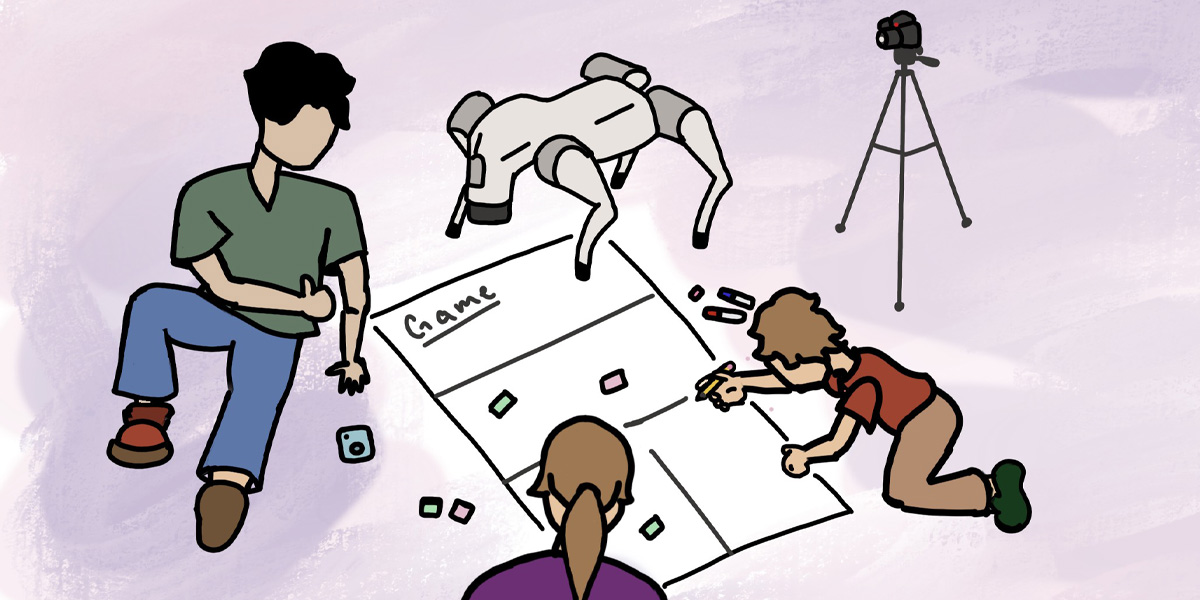A TRAILS pilot study looks at how families can use AI robotic animal companions in support services for autistic children

Illustration by Zainab Noor Shamim
Accessing healthcare support is crucial for autistic children, providing long-term benefits that can extend into adulthood. Recognizing the significant challenges that families face in accessing these specialized support services, researchers at the University of Maryland (UMD) and George Washington University (GW) are designing an intelligent robotic companion animal to increase access by serving as part of a human-robot team as a complementary solution within the home environment.
Associate Professor Hernisa Kacorri from the UMD College of Information Studies, along with Associate Professor Chung Hyuk Park and Professor Zoe Szajnfarber from GW, are piloting the research project, which is part of the NSF Institute for Trustworthy AI in Law & Society (TRAILS), a multi-institutional effort to develop new artificial intelligence (AI) technologies designed to promote trust and mitigate risks. It received seed funding for one year and with promising results, will become a larger project.
Beyond the immediate benefits for autistic youth, advancements with the AI robot set the stage for wider applications of robot-assisted living. The strategies and technologies developed through this project can pave the way for future innovations, making robot integration in homes safer, more effective, and ultimately more inclusive and trustworthy.
Co-Designing with Families
“We saw a critical need to create a robotic solution to assist caregivers in providing support within the home environment,” says Park.
“It’s important to note that our goal isn’t to replace current intervention methods but rather to supplement them,” says Szajnfarber. “By introducing robotic assistance as part of the caregiver-therapist team, we aim to extend the reach and effectiveness of available services and provide much-needed support to families facing these challenges.”
The scope of this research extends beyond designing a robotic companion capable of engaging children. It also involves an in-depth exploration of how these robotic companions can be embraced by families and how different modes of interaction with the technology can impact their trust in it.
“In our project, we recognize the significance of involving all stakeholders, including autistic children, their parents or caregivers, and support specialists,” says Kacorri. “Through participatory design processes, we aim to actively engage these diverse stakeholders to understand their unique needs and preferences.”
By closely working with families and children, the researchers aim to gather insightful feedback that will further refine the design and functionality of the robotic companions to meet the specific needs of users.
“We’re committed to engaging with the autistic community and their families to ensure our solutions meet their needs,” they say.
Multi-Sensory Perception and Personalized Learning
The researchers will focus on two innovations aimed at enhancing the interaction between humans and robots. The first innovation involves refining how robots perceive and engage with their human counterparts. By equipping robots with the ability to utilize multiple senses—akin to hearing, seeing, and even feeling—they hope to foster a natural interaction.
The second innovation focuses on personalization. Through developing advanced learning algorithms, robots can be designed to adapt their behavior and interactions based on the unique needs and preferences of each individual. This means that the robot can learn and grow with its human companion, tailoring its responses and actions to better support and engage in meaningful ways.
These innovations represent a significant step forward in improving the effectiveness and usability of assistive technology for autistic youth. By enhancing the way robots understand and react to human emotions and behaviors, and personalizing their learning to accommodate individual differences, the research team is laying the groundwork for a future where robots can serve as more than just tools or assistants—they can be companions and supporters.